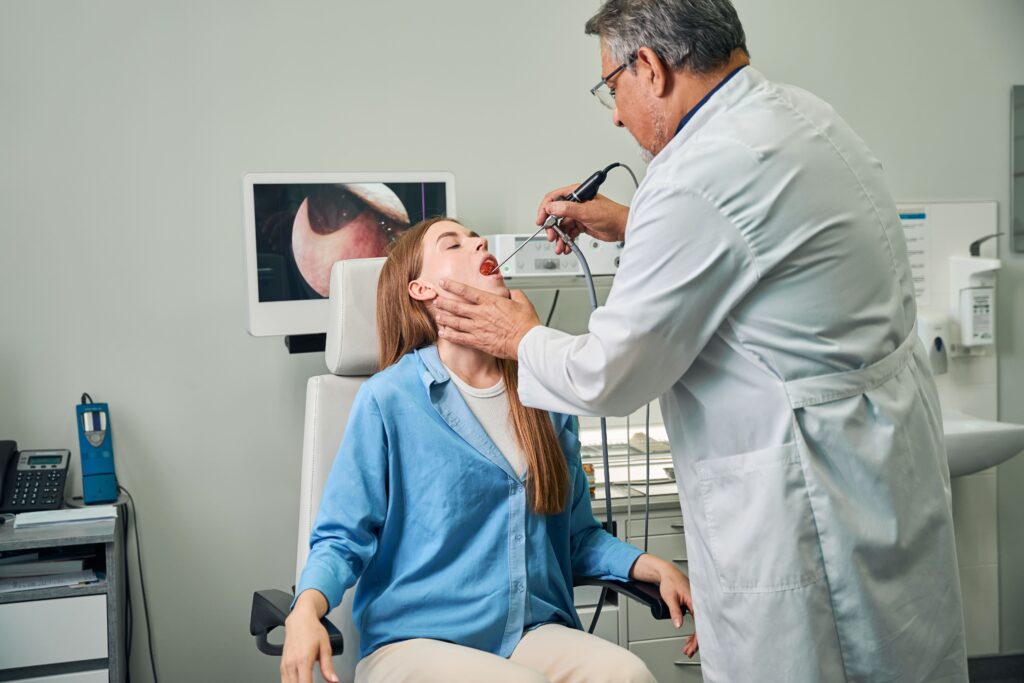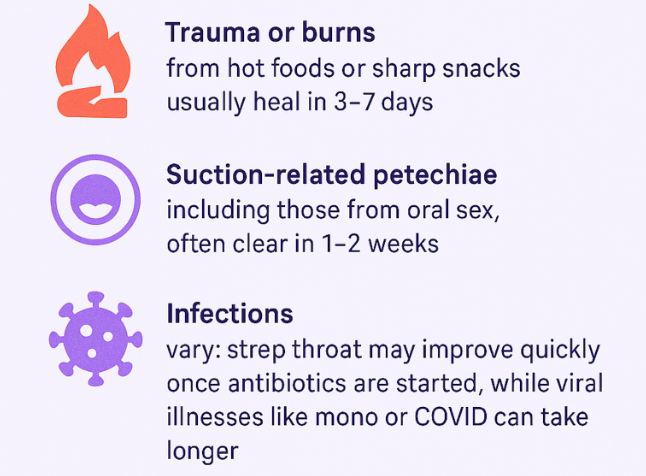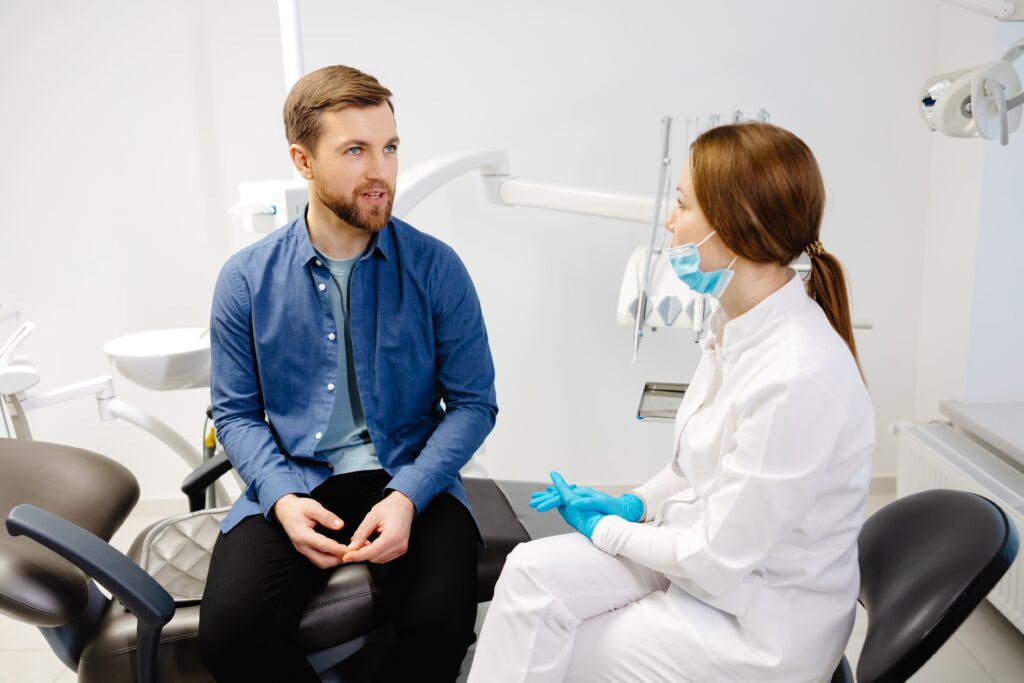Key Highlights
- A bruised palate, or palatal petechiae, are tiny red-purple spots caused by trauma, suction, or infection.
- Minor cases heal in 3–7 days, suction-related spots in 1–2 weeks.
- See a dentist/doctor if spots spread, last longer than 2 weeks, or occur with fever or trouble swallowing.
Have you ever noticed tiny red or purple spots on the roof of your mouth and wondered what they mean? As a dentist, I often see patients worried about what we call a bruised palate, medically known as palatal petechiae.
Most of the time, these spots are harmless, maybe from eating something sharp, drinking hot coffee, or even from suction or straining. But sometimes, they can signal infections like strep throat or mono, or less commonly, a bleeding issue.
I’ll walk you through what causes a bruised palate, how long it usually lasts, when you can manage it at home, and the signs that mean it’s time to see a professional.
What Is a Bruised Palate (Palatal Petechiae)?
A bruised palate, also called palatal petechiae, refers to small, non-blanching red or purple spots on the roof of the mouth. They form when tiny blood vessels (capillaries) break due to trauma, infection, suction, or straining. Unlike regular irritation that turns pale when pressed, petechiae remain red or purple.
These spots are usually harmless but can sometimes signal conditions like strep throat, mononucleosis, or blood-related issues.
What Are the Symptoms of a Bruised Palate?
A bruised palate, or palatal petechiae, doesn’t look the same in everyone. The most common signs include:
- Pinpoint reddish-purple spots on the roof of the mouth
- Spots that are typically 2 millimeters or larger
- Round or clustered marks that don’t disappear when pressed (non-blanching)
- Usually located on the soft palate, the flexible back portion of the mouth that helps with swallowing and speech
These symptoms help distinguish petechiae from other oral irritations or rashes. Unlike canker sores or irritation, palatal petechiae remain dark and non-blanching when touched. This makes them easier for a dentist to identify during an oral exam.
Recommended reading: Canker Sores & Pregnancy
What Causes Bruises on the Palate?

Trauma and Burns
One of the most common reasons for a bruised palate is direct trauma. Eating something sharp (like chips, hard bread), or accidentally poking the roof of your mouth with a utensil can break tiny blood vessels, leaving red or purple spots behind.
Burns from hot foods or drinks (like pizza, coffee, or soup) can also damage the delicate tissues on the palate. These are types of oral mucosal trauma and injuries that we often see on dental chairs. They can cause soreness, swelling, and temporary discoloration that looks like a bruise.
Most trauma- or burn-related bruises heal quickly on their own, usually within 3–7 days, as long as you avoid further irritation.
Recommended reading: What Causes a Bump on the Roof of the Mouth?
Oral Sex and Suction Trauma
Another common cause of a bruised palate is suction-related trauma.
During activities like using straws, repeated sucking habits, or sexual activity, the negative pressure inside the mouth can cause tiny capillaries in the soft palate to break.
In fact, research has documented cases of oral sex-related trauma leading to palatal petechiae. These bruises are harmless and usually resolve on their own within one to two weeks without treatment.
Because of their location, suction-related bruises can sometimes be mistaken for signs of infection. It’s always a good idea to have them checked if they don’t heal within the expected timeframe.
Related: Chlamydia Bumps on Tongue
Infections
A bruised palate can also appear as part of an infection. Certain illnesses are well known for causing palatal petechiae, including:
- Strep throat. Often paired with fever, sore throat, and swollen tonsils.
- Mononucleosis (mono). May cause fatigue, swollen glands, and palatal spots.
- Viral infections such as adenovirus, cytomegalovirus (CMV), and even COVID-19, can inflame delicate tissues in the mouth.
- Fungal infections like oral thrush may cause white patches that irritate or bruise nearby tissue.
In these cases, palatal petechiae are a signal of an underlying illness rather than trauma. If infection is suspected, dentists may order a rapid strep test, throat culture, or bloodwork to confirm the cause before treatment.
Recommended reading: Best Tea for Sore Throat
Straining, Coughing, or Vomiting

A sudden increase in pressure inside the mouth or throat can also lead to a bruised palate. Activities like intense coughing, forceful vomiting, or heavy straining (such as during exercise or lifting) may cause tiny blood vessels in the soft palate to burst.
These bruises are usually harmless. They fade within a few days once the pressure episode passes.
However, if palatal petechiae appear frequently without a clear cause, it may point to an underlying bleeding or clotting problem that should be checked by a doctor.
Blood Disorders, Medications, and Vitamin Deficiencies
Sometimes a bruised palate isn’t caused by trauma or infection at all but by underlying health conditions that affect how blood clots.
Blood and platelet disorders:
Conditions such as thrombocytopenia (low platelet count), immune thrombocytopenia (pediatric ITP), and leukemia can all cause petechiae in the mouth.
Because these disorders reduce the body’s ability to control bleeding, even minor pressure on the palate may result in visible bruising.
Medications:
Certain drugs, especially blood thinners, increase the risk of bleeding.
There are reports of anticoagulants causing soft palate and uvula hematoma as well as retropharyngeal hematoma linked to warfarin use, where blood collects behind the throat and can become a medical emergency.
Vitamin deficiencies:
Nutritional issues may also play a role.
For example, scurvy (severe vitamin C deficiency) can cause palatal petechiae in children.
More broadly, vitamin deficiencies in children and vitamin K deficiency may interfere with proper blood clotting, increasing the chance of bruising inside the mouth.
If bruising appears without an obvious trigger, or if it recurs often, it’s important to seek medical advice to rule out these underlying causes.
Recommended reading: 7 Ways to Cure Mouth Ulcers Naturally
What Does It Mean if the Roof of Your Mouth Is Purple?
A purple or dark spot on the roof of your mouth usually means blood has pooled under the tissue. This looks similar to a bruise on the skin and is sometimes called a palatal hematoma.
Most of the time, it comes from something simple like trauma or suction. But in some cases, a purple palate may be a sign of a bleeding or clotting problem. Blood disorders, blood thinners, or vitamin deficiencies can make bruising more likely.
These changes can sometimes point to underlying medical conditions that should be checked by a doctor.
How Doctors Diagnose a Bruised Palate

Dentists usually start with a simple oral exam. They look at the spots on your palate to see if they blanch (fade) when pressed or if they stay red or purple. They also note the pattern and location of the lesions, which can give important clues.
Next, they’ll ask about your medical history and symptoms. Things like recent sore throats, fevers, coughing, or habits that might cause trauma.
If the cause isn’t obvious, your dentist or doctor may order tests such as:
- A throat swab or bacterial culture to check for strep throat
- A mono test if symptoms suggest Epstein-Barr virus infection
- Bloodwork, including a complete blood count (CBC), platelet count, C-reactive protein (CRP), procalcitonin (infection marker), and prothrombin time (PT) to check clotting
- Urinalysis if a broader infection is suspected
These steps help rule out serious causes while confirming whether your bruised palate is just a minor issue or linked to an underlying condition.
How to Heal a Bruised Roof of the Mouth
Most cases of a bruised palate heal on their own within a few days to a week. While you wait, there are simple ways to ease discomfort and help your mouth recover.
At-Home Relief
- Saltwater rinse. Mix 1 teaspoon of salt in ½ cup of warm water. Swish gently for 30 seconds, then spit. Do this 2–3 times a day.
- Cold therapy. Soothe the area with ice chips, chilled drinks, or popsicles.
- Soft diet. Stick to gentle foods and avoid anything spicy, acidic, or rough that could irritate the palate.
- Gentle rinses. Choose an alcohol-free mouthwash to keep the area clean without burning.
- OTC pain relief. Ibuprofen or acetaminophen can help reduce soreness and inflammation.
Medical Treatment
If your bruised palate is linked to an infection like strep throat, your provider may prescribe antibiotics. Viral infections, such as mono or COVID, do not respond to antibiotics and need time and supportive care.
Sometimes, a bruised palate appears with other conditions such as an itchy roof of mouth from allergies or irritation, or even a peeling palate caused by burns or reaction to certain products.
If you’re not sure which one you’re experiencing, it’s best to check in with your dentist.
How Long Does a Bruised Palate Last?
The healing time for a bruised palate depends on the cause:
- Trauma or burns from hot foods or sharp snacks usually heal in 3–7 days.
- Suction-related petechiae, including those from oral sex, often clear in 1–2 weeks.
- Infections vary: strep throat may improve quickly once antibiotics are started, while viral illnesses like mono or COVID can take longer.
If a bruised palate hasn’t improved within two weeks (or if new symptoms develop) it’s best to schedule a dental or medical checkup.

How to Prevent a Bruised Palate
Not every case of a bruised palate can be avoided, but you can lower your risk with a few healthy habits. Protecting your mouth from trauma and following good hygiene practices can go a long way in preventing both injuries and infections.
Prevention tips include:
- avoid oral trauma (sharp foods, suction habits, risky behaviors)
- wash hands
- disinfect surfaces
- avoid sharing utensils
- cover coughs and sneezes
- stay home when sick
- follow safe food handling and hygiene
You can find more detailed guidance in the CDC’s prevention tips.
When to See a Dentist or Doctor

Most bruised palates are harmless and heal on their own. Still, some situations call for professional care. If you notice any of the following, it’s best to get checked:
- Spots lasting longer than 2 weeks
- Fever, sore throat, or swollen lymph nodes
- Difficulty swallowing or breathing
- Large or unexplained bruises elsewhere on the body
Children: unexplained petechiae may be a sign of abuse or neglect.
For children especially, these findings can be serious. Dentists, doctors, and all healthcare providers are legally required to report suspected abuse or neglect. This safeguard exists to protect vulnerable patients who may not be able to speak for themselves.
If you are concerned about a child’s safety, or if you are in a situation where you need help, you can call the Childhelp National Child Abuse Hotline at 1-800-422-4453. Trained counselors are available 24/7 to provide confidential support, guidance, and connections to local resources.
FAQs
What causes bruises on your palate?
A bruised palate can come from trauma (sharp foods, burns, suction), infections like strep or mono, or bleeding issues.
How to heal a bruised roof of the mouth?
Most heal in a few days with saltwater rinses, cold drinks, soft foods, and pain relievers. Infections like strep may need antibiotics.
What does it mean if the roof of your mouth is purple?
A purple palate often means pooled blood under the tissue, called a palatal hematoma. Sometimes it signals a clotting or bleeding problem.
How do you treat a palate hematoma?
Most heal with rest, soft foods, and saltwater rinses. If swelling is severe or doesn’t go away, see a doctor.
How do you treat a soft palate injury?
For cuts or burns, rinse gently with saltwater, avoid hot or spicy foods, and use OTC pain relief. Seek care if it doesn’t heal in a week.
Is a bruise a hematoma?
Not exactly. A bruise is a small bleed under the skin or tissue. A hematoma is a larger collection of blood that may swell or feel firm.
Is a bruised palate contagious?
No, unless it’s caused by an infection like strep throat or mononucleosis, which can spread to others.
Key Takeaways
- A bruised palate is often minor trauma, but can signal infection or systemic issues.
- Healing time ranges from a few days to 1–2 weeks.
- See a dentist/doctor if it’s persistent, spreading, or linked to other symptoms.
- Children with unexplained palatal petechiae need prompt evaluation.
Want more easy, reliable dental tips? Follow @joycethedentist on Instagram and TikTok for everyday advice to keep your smile healthy and bright.





















